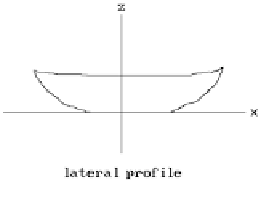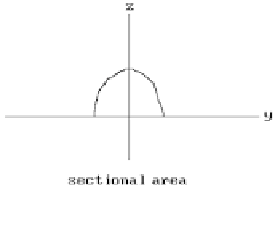Graphics Reference
In-Depth Information
Figure 12.31.
A simplified view of boat hull specification.
drawings, a smaller scale was used. Figure 12.31 shows a highly simplified view of
what was specified. In the shown coordinate system one would define a number of
orthogonal sectional views referred to as
sections
(x = constant),
buttocks
(y = con-
stant), and
waterlines
(z = constant). From this data one could compute other control
curves that would correspond to other sorts of sections. Their computation would
need a skilled craftsman. If any of these had undesirable shape features, one would
back up and change the initial form data and repeat the process until one was finally
satisfied.
A similar process was used in the manufacture of other surfaces such as those
needed in the aircraft and automobile industry. Using the approach just described
meant that the process was based on curves and the fairing of curves. In the aircraft
industry, “conic lofting” was popular, meaning that conic curves were used to describe
sections of aircraft fuselages. In boat building, least squares fitting polynomials were
found to be more useful. In the 1960s one started to use splines.
Another idea that started to take hold was the idea of fairing an entire surface
patch because dealing with large meshes of curves and data points was very time-con-
suming and complicated. The papers of Ferguson ([Ferg64]) and Coons ([Coon67])
(an earlier 1964 version of this paper was well known) had a great influence and intro-
duced the bicubic and Coons patch, respectively. From a single patch one moved on
to a grid of patches that was defined automatically from the grid of boundary curves.
Twist vectors were a major problem. Bézier ([Bézi71]) introduced Bézier curves and
surfaces. The nice thing about these objects was that it was much easier to manipu-
late their shape. One simply moved the control points in their control polygon. A
remaining problem was that the degree of the Bézier objects increased as the number
of control points increased unless one resorted to piecewise Bézier objects. This





